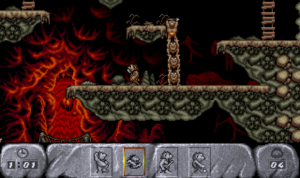The Humans
 And finally, we get to something that isn’t a RPG: The Humans, a 1992 cavemen-and-dinosaurs-themed puzzle-platformer. Although it isn’t the oldest game on the Stack, it’s probably the game that’s been on the Stack the longest — which came as a surprise to me when I compiled the list; for years, I thought that honor went to Bloodnet (a 1994 cyberpunk/vampire adventure game with some RPG elements). I suppose Bloodnet weighed more heavily on my sense of backlog guilt, because I abandoned it so near the beginning: for a time, when the Stack was much smaller, it was the one game that I felt like I hadn’t even given a serious try. (Today, I have over a hundred marked as not even tried at all.) Whereas I was fairly advanced in The Humans when I shelved it, putting it into extended I’ll-get-back-to-this-soon limbo.
And finally, we get to something that isn’t a RPG: The Humans, a 1992 cavemen-and-dinosaurs-themed puzzle-platformer. Although it isn’t the oldest game on the Stack, it’s probably the game that’s been on the Stack the longest — which came as a surprise to me when I compiled the list; for years, I thought that honor went to Bloodnet (a 1994 cyberpunk/vampire adventure game with some RPG elements). I suppose Bloodnet weighed more heavily on my sense of backlog guilt, because I abandoned it so near the beginning: for a time, when the Stack was much smaller, it was the one game that I felt like I hadn’t even given a serious try. (Today, I have over a hundred marked as not even tried at all.) Whereas I was fairly advanced in The Humans when I shelved it, putting it into extended I’ll-get-back-to-this-soon limbo.
I abandoned the game the first time around due to frustration over its pixel-precise demands. And yes, the game does make the gaps I have to jump uncomfortably wide sometimes, so that my first attempt falls short, and my second attempt falls down before jumping as a result of trying not to fall short. But in truth, it wasn’t just the game’s demands that caused my frustration, but my own demands on top of them. In those days, I was not just a completist, but a perfectionist. The game provides you with a limited number of lives — okay, it’s not quite that simple. The game puts multiple cavemen on each level, and lets you switch control between them Lost Vikings-style. If one of them dies, he 1I use the masculine pronoun because there don’t seem to be any females, which makes me fear for the future of the tribe. is immediately replaced by a spare, but you can run out of spares. The number of cavemen you have available persists from level to level, and only increases if you rescue a captive on the occasional level where that’s an option. So, to my younger self, part of the challenge here was to make my tribe as large as possible — that is, to do all the rescues and never let anyone die unless a puzzle demands it. (Sometimes the only way to sneak one caveman past a hungry dinosaur is to take advantage of the delay while it eats another caveman. This is not a very good-hearted game.) Note that this doesn’t really affect your ability to finish the game: you can jump in with a full set of lives at the beginning of any level. There’s a scoring system that would be affected by this, but I didn’t care about that even in my perfectionist days. No, hoarding all those lives was just a self-imposed challenge that I’m willing to forgo today.
I recall attempting the game again some years later and finding that it disagreed with my newer sound hardware. The sounds here aren’t anything special, really — just a bunch of looped tunes that play in the background — but I deemed it to be an essential part of the experience anyway (for reasons I may elaborate in my next post), and reshelved it again. DOSBox takes care of that, of course. But for some reason, DOSBox crashes the installer. I seriously thought for a while that I wasn’t going to be able to play this game: it refuses to run until it has a config file telling it about your sound and video hardware, and the only way to generate that is with the installer, which brought down DOSBox in impressive manner, with ill-formatted double-wide text and a completely unresponsive prompt. Fortunately, I was able to run the installer natively, even though the game itself balks at this treatment.
| ↑1 | I use the masculine pronoun because there don’t seem to be any females, which makes me fear for the future of the tribe. |
|---|
 Comments(0)
Comments(0)